Research on inversion method for stress characteristics of roadway surrounding rock based on real-time weight measurement of drill cuttings
IF 3.5
2区 计算机科学
Q2 COMPUTER SCIENCE, INTERDISCIPLINARY APPLICATIONS
引用次数: 0
Abstract
The concentration of internal stress and the accumulation of energy within coal bodies are key factors that can trigger catastrophic events, such as rock bursts and gas outbursts. Therefore, understanding the internal stress characteristics of coal is essential. The cuttings method, a commonly used detection technique, is often employed to reflect the degree of stress concentration in coal bodies. However, there is currently insufficient research on the relationship between the weight of cuttings and the stress of the coal body, making it difficult to quantitatively and accurately represent the actual stress state of the surrounding rock in boreholes. This study investigates the relationship between cuttings weight and coal body stress through both theoretical analysis and numerical simulation. Theoretically, a formula for calculating the weight of cuttings under a uniform stress field was derived, based on an analytical solution for the stress and displacement of surrounding rock in boreholes. The sensitivity of cuttings weight to changes in coal body stress is thoroughly analyzed. From a numerical simulation perspective, a discrete element method for coal drilling is developed, revealing the correlation between cuttings weight and coal body stress under both uniform and non-uniform stress conditions, as well as the impact of initial damage on cuttings weight. Additionally, a continuous damage model is constructed of the surrounding rock along the depth dimension, investigating how cuttings weight varies with drilling depth. Based on these findings, an automatic method is proposed for weighing cuttings to locate and estimate the magnitude of lateral stress peaks in roadway-surrounding rock. Field application experiments demonstrate the effectiveness of this method, yielding promising predictive results. The findings of this research provide both technical methods and theoretical support for using cuttings weight to quantitatively characterize coal body stress, which is crucial for accurately assessing coal body stress and for the early detection and warning of dynamic impact hazards.
基于钻屑实时称重的巷道围岩应力特征反演方法研究
煤体内部应力的集中和能量的积聚是引发地压、瓦斯突出等灾难性事件的关键因素。因此,了解煤的内应力特征至关重要。岩屑法是反映煤体应力集中程度的一种常用检测技术。然而,目前对岩屑重量与煤体应力之间的关系研究不足,难以定量准确地表征钻孔围岩的实际应力状态。通过理论分析和数值模拟研究了岩屑重量与煤体应力的关系。从理论上推导了均匀应力场下岩屑重量的计算公式,该公式基于钻孔围岩应力和位移的解析解。深入分析了岩屑重量对煤体应力变化的敏感性。从数值模拟的角度,建立了煤炭钻井的离散元方法,揭示了均匀和非均匀应力条件下岩屑重量与煤体应力的相关性,以及初始损伤对岩屑重量的影响。此外,建立了沿深度维度的围岩连续损伤模型,研究岩屑重量随钻井深度的变化规律。在此基础上,提出了一种自动称重岩屑的方法来定位和估计巷道围岩的侧向应力峰值大小。现场应用实验证明了该方法的有效性,得到了较好的预测结果。研究结果为利用岩屑重量定量表征煤体应力提供了技术方法和理论支持,对准确评估煤体应力、早期发现和预警动态冲击灾害具有重要意义。
本文章由计算机程序翻译,如有差异,请以英文原文为准。
求助全文
约1分钟内获得全文
求助全文
来源期刊

Simulation Modelling Practice and Theory
工程技术-计算机:跨学科应用
CiteScore
9.80
自引率
4.80%
发文量
142
审稿时长
21 days
期刊介绍:
The journal Simulation Modelling Practice and Theory provides a forum for original, high-quality papers dealing with any aspect of systems simulation and modelling.
The journal aims at being a reference and a powerful tool to all those professionally active and/or interested in the methods and applications of simulation. Submitted papers will be peer reviewed and must significantly contribute to modelling and simulation in general or use modelling and simulation in application areas.
Paper submission is solicited on:
• theoretical aspects of modelling and simulation including formal modelling, model-checking, random number generators, sensitivity analysis, variance reduction techniques, experimental design, meta-modelling, methods and algorithms for validation and verification, selection and comparison procedures etc.;
• methodology and application of modelling and simulation in any area, including computer systems, networks, real-time and embedded systems, mobile and intelligent agents, manufacturing and transportation systems, management, engineering, biomedical engineering, economics, ecology and environment, education, transaction handling, etc.;
• simulation languages and environments including those, specific to distributed computing, grid computing, high performance computers or computer networks, etc.;
• distributed and real-time simulation, simulation interoperability;
• tools for high performance computing simulation, including dedicated architectures and parallel computing.
 求助内容:
求助内容: 应助结果提醒方式:
应助结果提醒方式:


